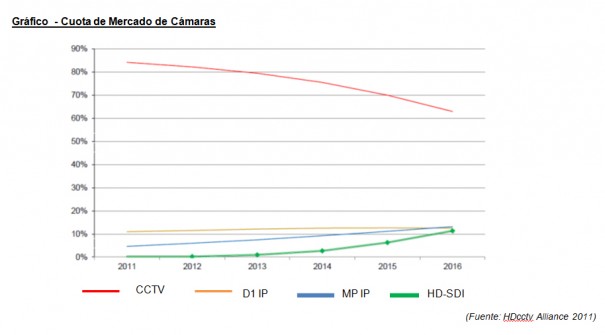What have been the latest developments in CCTV?
Closed Circuit Television (CCTV) has been one of the pillars of security systems for decades. Gerardo Cuervo Chavez, Lilin's Head of Networking, manufacturer of IP video and traditional CCTV solutions for professional customers, says in this article that CCTV security systems are increasingly committed to IP and HD-SDI technology, that have significant advantages compared to traditional analog systems.
Closed Circuit Television (CCTV) is a composite image transmission system, basically, by a certain number of cameras and monitors, in which signals are transmitted from the cameras to the monitors, but, How have these devices improved to adapt to markets in recent years??
Until very recently, the technologies available for CCTV were limited to two: Analog or IP CCTV. For applications where high definition is not required but it is required to keep the cost low, the analog CCTV option is—and for quite a while, will be— the most appropriate solution chosen by the market. instead, needing more definition users choose to abandon analog CCTV (whose definition, By the way, is limited to the old PAL/NTSC TV standards) and choose IP equipment. Although when using data transmission networks IP equipment has no limitation in terms of image quality, in recent times the market has noticed certain problems when executing a project with IP technology.
These problems are due to compression/encoding – transmission – decompression/decoding of the image, processes that reduce the quality of the initial image, adding a small delay in the transmission from when it was captured by the camera until it is viewed at the monitoring post.
If the installation has not been carefully designed and executed, some network bottlenecks and lack of software/hardware resources in decoding can make the image transmission delay even greater. These drawbacks are the most pronounced by users and produce a certain dissatisfaction, especially when real-time monitoring is important. This is where the new HD-SDI standard can make a difference., making your application interesting in places such as casinos, Airports, urban security, banks and other sites with high demands.
What is HD-SDI?
As his initials suggest (High Definition Serial Digital Interface) is a standard for high definition streaming, based on a serial data interface. This serial data travels by a single driver (coaxial cable or fiber) at a rate close to 1,485Gb/s, and are used to stream digital video without encoding or compressing. In case of using a coaxial cable, the connection can be extended to the 300 M, as long as the cable is of good quality.
Since the image is transmitted without compressing or encoding, has the highest quality that allows the format and no additional delay is added. This standard is currently used in broadcasting (Producers, HD TV transmitters and channels) and with it its success as a high definition medium that is already duly proven. As a result of this, as an additional advantage when applying in CCTV, is that ccds and other components that are currently already used in broadcasting can be used, whose claims for quality, definition, stability and durability are extreme.
Application and future of HD-SDI in CCTV
While HD-SDI-based monitoring systems have obvious advantages, there are still certain negative aspects that need to be resolved. For example, connecting devices over long distances (by coaxial, limited to 300 m at best, unless fibre optics are used), the need for greater video storage capacity, the lack of popularity of HD-SDI equipment and the fact that it is not produced in significant quantities means that the costs of the same are very high at the moment. On the other hand, there are special needs where the required definition is greater than that which can handle an HD-SDI device (today, 720p and 1080p).
Over time surely more manufacturers will be able to offer more variety of equipment in HD-SDI. And if the production quantities allow it, the costs of the devices will fall., making this technology viable in lower-budget applications.
Today, IP technology is one of the main allies in terms of video surveillance and more and more companies are tending to install this type of solutions. but, What is the reason for this phenomenon??
• Digitization
The IP system used for CCTV is composed of cameras that allow to obtain better resolutions and higher image quality than analog systems, thus enabling easy and fast incident recognition, access control, Fire, among other events. this, added to the flexibility that gives the way data transmission, being able to send over a UTP cable, by fiber or by a wireless link, makes them practically usable for any need that arises in the market.
• Storage
Cameras have configuration systems, video management and recording. They also have intelligent functions such as event search, motion detection, facial detection, audio detection, anti-sabotage detection, sending email as an alarm notification, among other advanced features such as those included in iMegapro cameras. Recording is done on the hard drive, image capture is simple, its consistent quality and allows access to videos through IP networks, ensuring greater fidelity than another system can offer.
• Integration
Closed Circuit TV systems allow multiple additional devices to be incorporated into the initially installed system to expand the storage of images. The installation and integration of multiple equipment allows to guarantee an effective control and verification of the installation of video surveillance. IP systems are not only integrable with other technologies, they also allow remote access to all records from the same screen.
• Economy
Contrary to what is believed, the installations of IP systems are cheaper since the extra wiring costs it consumes are lower and, essentially, because it allows the use of wireless networks. Saving not only wiring costs, but also the costs of installation and its maintenance.
• New market trends
The new trends also lead the market to opt for HD equipment that provides panoramic view and from different perspectives on live or recorded scenes; all in high definition.
 According to data from the HDcctv alliance, according to the forecast up to the 2016 -as we can see represented in the graph- the market share of analogue cameras will be seriously harmed with a loss of up to a 20% of market share in sales and yet new products such as megapixel cameras and HD-SDI cameras grow to a 10% market share. New megapixel technologies offer more resolution and image quality, so it tends to grow strongly in market share and conventional, Analog, lose market at very fast paces.
According to data from the HDcctv alliance, according to the forecast up to the 2016 -as we can see represented in the graph- the market share of analogue cameras will be seriously harmed with a loss of up to a 20% of market share in sales and yet new products such as megapixel cameras and HD-SDI cameras grow to a 10% market share. New megapixel technologies offer more resolution and image quality, so it tends to grow strongly in market share and conventional, Analog, lose market at very fast paces.
Gerardo Cuervo Chavez
Responsible for Networking of Lilin Spain
You liked this article?
Subscribe to our RSS feed And you won't miss anything.




